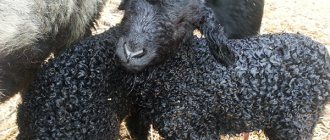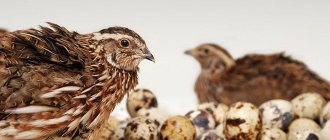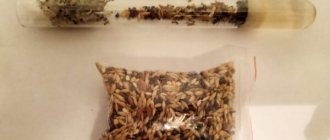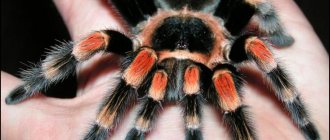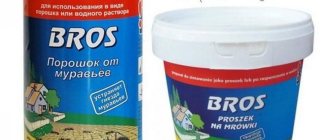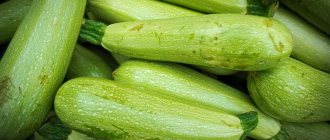To replenish the goat population, you should follow the recommendations regarding the selection and further maintenance of goats and breeding males. In addition, it is necessary to carefully monitor the pregnancy of females, and after birth, properly care for the kids. These features are the main ones when breeding goats at home.
Since this process requires increased attention from the owner, we recommend that you read this article, which describes in detail the signs of heat and pregnancy in females, possible difficulties during the lambing process, as well as recommendations for feeding lactating females and newborn kids.
- How to determine if a goat is pregnant
- Signs of lambing (video)
Breed selection
The breed should be selected in accordance with the intended purpose of breeding - to obtain meat, fluff or milk. Each breed has its own characteristics and nuances in terms of conditions of maintenance and nutrition.
Dairy
When purchasing dairy cattle, you should pay attention to the following external details:
- head – light and small in size;
- wide chest;
- straight back;
- straight, strong legs;
- an elastic, non-sagging udder (an udder that is too large indicates excess fat deposits and low milk yield);
- developed nipples.
Dairy breeds are capable of producing up to 10 liters of milk per day. Goat's milk is a hypoallergenic product that can be given to children from birth.
Downy
Animals that are bred for fluff and wool are distinguished by the following features in their body structure:
- body size is much larger than that of relatives of other breeds;
- very wide chest;
- straight back and strong limbs;
- wide sacrum and lumbar region;
- small head sizes;
- the coat grows evenly, evenly white;
- the fur on the head is soft, it is better if it falls over the eyes;
- the skin is smooth and does not form folds.
The wool of these goats is of much better quality and is highly valued in markets.
Meat
Goats of this type are kept mainly for meat. Milk is produced in small quantities, usually only enough to feed the young.
Characteristic features are a barrel-shaped round body and a small udder located high. Meat is considered dietary and has a healing effect for diseases of the digestive system, heart, blood vessels and blood diseases.
Decorative
Goats of these breeds are distinguished by their small body size, but at the same time their ability to produce milk. Thanks to their compactness, they can be maintained on a summer cottage of any size. They love to eat large amounts of grass, hay and leaves.
Goat meat
General information
Nowadays, goat breeding has become quite a popular activity all over the world. The main advantage of this animal is its unpretentiousness to food and care. In addition to meat, milk, skin and wool are also used.
There is an opinion that the smell of goat meat is so strong that it is simply impossible to get rid of it. However, this “aroma” does not come from the pulp, but from natural animal secretions - sweat and urine. To prevent it from spreading to the meat, first carefully remove the skin, and then thoroughly wash your hand, thereby preventing the smell from spreading.
In ancient times, many doctors perceived goat meat solely as a storehouse of vitamins and beneficial properties that help in treating the body from many diseases. This product is very easy to digest, and it is filled with all the microelements and amino acids necessary for a person.
Goat meat is also unique because it only contains more water than fat. It should be noted that these animals do not suffer from very serious diseases - tuberculosis and brucellosis, which cows very often suffer from. It contains less cholesterol than beef or pork.
Preliminary preparation
Before bringing the animal to the farm, it is necessary to prepare or build a special room in which the goats will be located, purchase or independently prepare food and provide a sufficient amount of water.
Premises requirements
Goats easily adapt to any weather changes and tolerate cold well. In summer it is better to keep them in a pen outdoors, and in winter - indoors.
Primary requirements:
- Good ventilation. Insufficient fresh air flow negatively affects livestock productivity.
- Space. These are quite active animals, so each adult will require at least 3-4 square meters. meters of area.
- Air temperature and humidity. For the cold season, the temperature should be at least +7-8 °C, and in summer - no more than +18-20 °C. Air humidity is recommended to be maintained at about 60%.
- You need to lay a bedding of hay or straw on the floor.
- The room should be well lit.
- It is better to make a separate extension for the kids.
Feeder and drinker
Proper maintenance and care of goats involves equipping special feeders and drinking bowls.
There are also certain requirements for feeders, as they must be safe for all animals, regardless of their gender and age.
Rules for equipping goat feeders:
- feeding holes must be of such a size that the animal can completely put its head into it and not get stuck there, but at the same time, so that it cannot crawl in there with its legs or completely;
- if the manger is a container without holes, it is better to make a box under it into which the remaining food will fall; it can then be poured back into the rest of the food;
- you need to make a separate compartment for pieces of salt;
- for kids that are kept in the same room with adults, you need to prepare holes at the level of their growth, separating their food from the “adult”;
- the feeder cannot be treated with protective agents, or they must be safe. This is because goats often chew the wooden parts of the feeder, so parts of the paint or other coatings can get into the feed;
- if the feed falls on the floor, the goats will no longer eat it, so you need to take care of the design of the feeder in such a way that the loss of feed will be minimal;
- It is advisable to place feeders on the wall opposite the entrance;
- the feeder should be equipped along the entire width of the wall so that the animals do not crowd, but stand in a row.
In addition to feeders, you need to provide drinking bowls for goats. They can be represented by a bucket or trough. For greater convenience, you can install automated drinking bowls.
Purchasing breeding animals
Before owning goats, you need to decide on your breeding goals and, depending on them, the breed of the animal.
When buying a dairy goat, there are several recommendations to consider:
- a young goat does not produce much milk, usually a good milk supply is noted after the second lambing;
- A healthy individual has 32 teeth and shiny fur;
- For a few days it is better to observe the goat you like, its behavior and character;
- To understand whether the milk will have an unpleasant odor, you need to sniff the animal between the horns - if you don’t feel anything unpleasant, then you will like the milk.
When purchasing, you need to pay attention to the quality characteristics of each individual breed.
You can buy breeding goats on special farms or from private breeders.
Features of feeding goat kids
For beginning farmers, caring for a goat is often associated with the need to learn all the basics of goat farming. If you want to constantly receive milk, you cannot do without mating and subsequent lambing of the pet, which means you will have to take care of the health of the kids.
In most cases, babies are born easily, but if the baby goat is stuck in the birth canal, you should immediately contact a veterinarian. It is easier to get emergency help with a preliminary agreement, so it is worth enlisting the support of a doctor in advance.
After birth, until 3 weeks of age, goat kids feed on milk. If the goat has increased lactation, then the kid is brought to the mother in the evening and left overnight, and bottle-fed during the day. This will allow you to regulate lactation. If there is not enough milk, you should increase the amount of concentrates in the goat’s diet and apply the kid to the udder more often.
As the kid gets older, concentrates, hay, cereals, and root vegetables are introduced into the diet.
Content specifics
Goats are unpretentious in keeping, so even for beginners there will not be any particular difficulties in breeding.
Spring, summer and autumn
After winter frosts, all rooms are cleaned and general cleaning is carried out. The bedding is replaced with new ones. Walls and floors are washed with laundry soap and soda diluted in warm water. After cleaning, airing is done. It is advisable to whitewash the walls with limestone.
In spring and summer, provided the weather is good, animals graze all day long. First you need to send them to sun-warmed areas.
Before walking, animals should be given a drink and until they get used to the greenery, lightly fed with hay.
Grazing should be done early in the morning, as direct sunlight can lead to heat stroke.
In the fall, they are again transferred to housing in a stall. This transition period lasts about a week.
in winter
During the cold season, livestock also need to be walked so that reproductive functions and the general health of the livestock are not impaired. Walking is much shorter than in summer - about 3 hours. Animals of downy breeds can be walked longer, as they tolerate the cold more easily.
It is better to feed and water indoors. At temperatures above +13°, you can walk and graze outdoors.
In winter, you need to comb the coat every day to remove dirt and parasites.
Features of keeping dairy goats
Keeping dairy goats is not much different from keeping other breeds of livestock. Basically, goats are kept alternating between stall and pasture farming. The stall should be dry, warm and light. The presence of drafts and holes through which the animal can escape is not allowed. A bedding of straw or hay must be placed on the floor. It is advisable to keep females separate from males, since the latter have a specific odor that can permeate goats. This will affect the quality and smell of the milk.
The barn must have: a feeding trough and a drinking bowl, a licker and a bed for the animals to rest.
It is also necessary to sharpen the hooves regularly as they grow throughout the life of the goats.
The size of the stall in a household is calculated depending on the size of the animal. The standard is a stall of 1.7 x 2.0 x 1.2 meters. If it is too crowded for the goat, she will produce half as much milk.
No grazing
This method of maintenance is used only in those areas and regions where the cold period is the main one or the frosts are too severe. The conditions of detention are the same as for the stall method. You can walk the goats in a fenced paddock.
The main difference between keeping without grazing is that animals cannot independently find food from fresh herbs. Therefore, the owner must provide the livestock with a sufficient amount of grass, hay and vitamins, which livestock usually receive during grazing. It is also necessary to provide a sufficient amount of light, since in the dark goats become weaker and their productivity is significantly reduced.
Useful properties of goat meat
Composition and presence of nutrients
This meat is very rich in amino acids, which are essential for our body. Goat meat contains many vitamins: thiamine, retinol, riboflavin and others.
Useful and healing properties
Goat meat is important for our body because it contains fatty acids. The most important advantage of this product is that it is not affected by any parasites.
Nutritionists always recommend goat meat to older people who suffer from atherosclerosis, heart disease and those with weakened immune systems.
From time immemorial, goat meat was considered a “natural first aid kit.” It should be noted that goat meat contains a small percentage of fat compared to pork and lamb. This makes this product dietary, which is why it is so popular. It is recommended for older people due to its low cholesterol level, which is significantly lower than that of other representatives of the animal world. The most delicious and, perhaps, the healthiest meat is the meat of fairly well-fed goats, which are only 1.5 months old. This pulp is distinguished by its delicate consistency and the absolute absence of any odor. For this purpose, the kids are specially fed with goat’s milk until the deadline for slaughter and sometimes fed with wheat or rye bran.
The meat of castrated animals is in no way inferior in taste. People call such goats vahuli. Their pulp contains the same content of useful substances and vitamins as young goats, which are much more difficult to find on our shelves.
In cooking
Goat meat is slightly lighter in color than lamb, and the fat is white and accumulates in the abdominal cavity. It can also be deposited under the skin, but in small quantities.
You can cook anything from young goats, but it has long been customary to pickle old goats. Without this procedure they do not begin to cook. Young red wine is used for the marinade, but sometimes white wine is also added, and garlic and a number of spices are added to it. Goat chops are very juicy. It can be stewed, and as a side dish you can use either potatoes or any other dish.
Currently, this product is in great demand among the most famous restaurants in the world. The meat is cut into small cubes, then salted and lightly sprinkled with pepper or other spices. After this, it can be fried with vegetables, stewed, boiled with prunes or beans. It should be noted that meatloaves from it are simply delicious.
Dangerous properties of goat meat
This product cannot cause any harm to the body. The only limitation for its use is individual intolerance.
Among goats there are also quite amazing breeds, one of them is the myotonic. This is the scientific name, but in real life they are called fainting. They received this name for a reason, since this breed really faints with every fright. Even surprise causes muscular paralysis in them.
Feeding
Goats are unpretentious in matters of nutrition. The main thing is that the food is clean and fresh. This greatly simplifies care and maintenance.
Organization of feeding
The diet should be designed in such a way that it is nutritious and balanced. The main food is hay and grass.
To increase productivity, grain concentrates, vegetables, and branches of deciduous trees are added to the menu. You can also give special feed and food waste.
Salt and vitamin complexes are required in the daily diet of goats.
Feeding methods
When organizing feeding, it is important to follow a routine. It is advisable to feed livestock at least 3 times a day at the same time.
It is advisable to give roughage, which is more difficult to digest, in the first half of the day, and succulent food in the evening.
How to water goats
There must be enough water. One animal consumes up to 10 liters per day. Water can be either freely available or issued on a schedule. In both cases, it is imperative to monitor the purity and temperature of the liquid. The optimal temperature is not less than 6, but not more than 10 °.
Water is given in the same way as food - three times a day. It is important to remember that if the liquid is overheated, it is contraindicated.
Summer diet
In the warm season, the main diet is succulent feed and additional feeding in the form of grain and legumes. In summer, goats consume up to 9 kilograms of grass per day. By the end of the season, the grass dries out and burns out, so you need to feed the animals with vegetables.
Winter nutrition
In winter, food should be more nutritious and rich, since pregnancy and lambing usually occur during this season, and in winter animals especially need additional vitamins and minerals. Therefore, you cannot do without concentrated feed.
The main products are hay, grain and legume concentrates, animal feed and vegetables. Dried leaves and bone meal can also be given.
Goats are the best choice for livestock
- These are one of the most unpretentious individuals both in maintenance and care, and in feeding.
- Compared to sheep, roes are much cleaner and smarter.
- They become more attached to humans than many other domestic animals.
- Feed is required six times less than a cow.
- They even eat food that other pets cannot and will not eat - they even use twig food. Absolutely everything will be used as feed: from straw to tops and weeds.
- Anyone can make a room for them - this does not require any special knowledge or skills, and you can also use any construction waste to build it.
- All you need to get started is: a small plot of land, some DIY equipment, your time and a little effort.
- Products obtained from whitetails have a number of excellent advantages and valuable qualities.
Milk:
- There is no allergy to goat milk;
- goat's milk has much smaller fat molecules than cow's milk, so it is more easily absorbed by the body at any, even the earliest age;
- goat's milk, unlike cow's milk, has an alkaline reaction, and therefore people, even those suffering from heartburn, can drink it;
- the amount of vitamins in goat milk is many times higher than in cow milk;
- goat milk has a composition that helps the human body successfully fight diseases and strengthens the immune system;
- milk is bactericidal, so it can be stored for a very long time even without refrigeration;
- Its fat content is higher than that of cow milk (from 4 to 6%).
Meat:
- In terms of protein content, goat meat is close to lamb, but contains less fat;
- Goat meat is better absorbed by the body and does not cause allergies.
Wool:
- very durable, light, easy to spin;
- down not only has the best qualities as a material, but also has valuable healing properties.
Manure is an excellent fertilizer for field cultivation and gardening. Compared to cow manure, it is required two to three times less for the same amount of area.
Animal care
To maintain productivity, it is important to provide meticulous care, which includes keeping the goat house clean, brushing the coat, proper nutrition and regular walking.
For the females
The goat's fur needs to be brushed and combed regularly. This allows you to get rid of excess matted hair and parasites. The barn in which the animals are kept is equipped with beds, since goats like to rest on a hill.
You should also trim and clean your hooves regularly. The procedure is carried out with great care, as the animal’s legs can easily be injured.
The premises must be cleaned daily of manure and feed residues.
Females should definitely be walked. A long stay in the fresh air has a beneficial effect on the quantity and quality of milk.
For newborn goats
Kids are usually kept separately from the rest of the herd.
Rules for caring for newly born goats:
- They are transferred immediately after birth, waiting until the fur is completely dry.
- In the first hour of life, they must be fed with expressed mother's milk.
- For the next 10 days, the kids are bottle-fed, then accustomed to eating from a bowl.
- In the first month, meals are four times a day, then you can switch to an adult diet.
- The bedding in the stall should be changed several times a day.
For the young
Raising goat kids requires more attention and labor from the farmer than caring for adult goats:
- The bedding must be made of fresh straw, as kids sometimes chew it.
- In the warm season, young animals are allowed to walk.
- At the age of six months, adolescents are usually transferred to the stall method of housing.
- The room in which the young animals are kept must be dry and warm, without drafts and high humidity.
Up to 4 months it is allowed to be kept next to the mother, but throughout the lactation period the goat produces such an amount of milk that is only sufficient to feed the offspring.
Behind the goats
Male goats are kept separately because of their unpleasant odor, which permeates the milk.
It is important to monitor the animal’s weight, as obesity reduces its reproductive function.
Otherwise, care is the same as for other goat livestock.
Dairy and down goat breeding
Goat breeding on a personal farm has two directions: dairy and down. Dairy goats are kept to produce highly nutritious milk, butter, fat, cottage cheese, and goats are kept to produce tender, tasty meat. Meat and fluff are obtained from downy breeds.
The best dairy breeds: Saanen, Gorky, Russian dairy, Megrelian. Perhaps the most unpretentious to growing conditions are representatives of the Saanen breed. They are distinguished by early maturity, good health, high fertility and longevity. Saanens are often used to improve other breeds.
Fresh goat milk has healing properties. Hippocrates also claimed that if you constantly drink goat's milk , you can easily live up to 100 years. It is absorbed 5 times faster than cow's milk . There are many examples where infants deprived of mother's milk were fed goat's milk.
The best downy breeds: Orenburg and Pridonskaya. The Orenburg breed is distinguished by its large size, early maturity and high fertility. Twins and even four babies are often born. This trait is inherited.
Correct milking technology
To get the maximum amount of milk, you should learn how to milk a goat correctly.
Each individual requires an individual approach, but there are general rules:
- Milking begins a month before giving birth.
- First you need to lightly massage the udder. A few days before lambing, massage is not done, as the goat will not allow it to be milked.
- The first milking after lambing can be done an hour later, provided the animal is in good health.
- Before the process, it is better to give the goat warm water to drink for better milk flow. During milking, you can give your favorite treat so that the goat associates the procedure with positive emotions.
- The udder should be washed with warm water and wiped dry.
- Milk must be milked to the last drop, as its remains in the udder lead to the formation of mastitis.
- For proper milking, you need to take the nipple in your palm, squeeze and gently pull down.
You will learn a lot of interesting and useful information about milking goats, as well as the correct milking technique, from the following video.
How to milk an animal
You should start milking the goat after her colostrum period ends. As soon as the kids are born, they are transferred to a separate room and fed with mother's milk. Therefore, the first milk will be used to feed the young animals. The first drops are considered harmful, so they are poured out during milking. The rest of the milk is first given entirely to the kids, and later it can be mixed with impurities. After 2 weeks, the colostrum period ends, and a person can take part of the milk. After a month, the kids can be fed the same way as other goats, and all the milk can be collected. However, you can start milking a meat goat only after 2-3 months; until this point, the babies feed on milk.
Before milking, the goat's udder must be thoroughly massaged and the seals kneaded, after which the teats should be rinsed and wiped well, and you can begin milking the animal. Everything must be milked, leaving nothing behind, otherwise the animal may develop mastitis. After milking, the teats are wiped with a clean towel and lubricated with Vaseline or greasy cream to prevent cracks from forming.
It is necessary to provide the goat with a special enclosure so that it cannot move and can stand still. You can fix the animal on a hill and put some tasty treat in front of it. Then it will allow itself to be milked in peace. You need to talk to the goat kindly, otherwise she may not give milk.
Breeding
The first stage of goat breeding involves the purchase of young animals or pregnant goats. At the same time, it is important to clarify the pedigree and heredity of potential pets. Then the animals are selected and, if successful, a new population is received.
Selection of animals for breeding
In order for the young to be productive and healthy, you should choose parents who are not related and have the best quality indicators for the required trait among their relatives. To do this, it is better to choose a male and a female from different breeders.
Mating
Readiness for mating occurs at the age of 1.5 years. It is better to carry out mating in the fall, since this is the most active period of sexual hunting in females. For young, inexperienced goats, you need to choose an appropriate goat. In one day, a male can fertilize a maximum of two females.
If, after 3 weeks after mating, the goat goes into heat again, then mating should be repeated.
Most often, a goat is brought specifically for mating with a specific female.
Signs of the hunt
You can tell that a goat is ready to mate by the start of heat, which lasts 2-3 days every 3 weeks.
Signs of sexual heat:
- genital hyperemia;
- mucous discharge;
- decreased appetite;
- the goat begins to wag its tail;
- if you run your hand along your back, it will bend and squat slightly;
- the goat does not run away from the male and does not show aggression.
The best time for insemination is 12 hours after the start of estrus.
Types of mating
Goat breeding is carried out in several ways:
- Manual mating - a person has complete control over the process. For successful mating, 2 cages are needed with an interval of 5 hours.
- Free mating. Animals must live side by side for 3 months, that is, the entire mating period, and mate at their own discretion.
- Harem mating. It means keeping one goat for a large number of females. After the end of the mating period, the goat is transferred to a separate stall.
How to do it correctly
For accuracy of fertilization, it is advisable to carry out mating in two steps with an interval. During the break, the male is taken away from the female. After 6 hours the mating is repeated.
Animals should not be overfed before mating.
A goat should be impregnated no more than once a year.
Goat mating
When carrying out mating, you need to know by what signs you can recognize hunting. At the beginning or end of the breeding period, these signs may appear weakly or completely absent. Signs of hunting are strongest from September to February.
The duration of the sexual cycle (from the first day of hunting to the beginning of the next) is 18-24 days, depending on the breed and individual characteristics of the animal. The hunt can last from 12 hours to four days.
It is worth considering that hunting is stronger in the middle of the season (from October to December). At this time, a greater number of fruitful fertilizations occur (Figure 3).
Signs of heat in goats are as follows:
- The external genitalia become swollen, pinkish or even red.
- Her behavior becomes restless and she often bleats.
- The goat begins to sniff more often, as it is attracted by the smell of the goat. To enhance the manifestations of hunting, you can stock up on a special “goat rag”. A piece of cloth is used to rub the glands located behind the goat's horns, and this cloth is stored in a jar with a tight-fitting lid. If necessary, the jar with a rag can be given to the female to sniff.
- The animal constantly twists its tail from side to side.
- Vaginal discharge appears. At the beginning of the hunt they are thick and opaque, then they become clear and liquid, and at the end of the hunt they become thick and white again.
Figure 3. Signs of hunting
A distinctive sign of hunting is a change in the nature of behavior. The queen begins to incite other animals in the herd to become restless and jump on herself. Goats, like other animals, exhibit the so-called standing reflex during the hunting period, when the goat calmly allows you to sit on it.
How to conduct mating correctly
The first hunt in young goats begins at four months of age, but the animal can only be bred after reaching a weight of 32 kilograms. Depending on the feeding regime and maintenance, females reach the body weight required for mating by 7-9 months.
On some farms, goats are not born until 12-18 months. This reduces milk supply but prolongs productive life. However, it should be taken into account that later mating (at one or one and a half years of age) can lead to obesity of the animal, which will negatively affect the production of offspring. An obese goat is less likely to go into heat, and cysts may appear on the ovaries, preventing fertilization and producing offspring. To reduce weight, you need to review the diet and increase the animal’s physical activity.
Note: Signs of heat usually begin to appear ten weeks after the longest day of the year. Between September and February, most goats are ready to breed and are easily bred. In April, signs of hunting begin to weaken and practically do not appear until September of the following year. A small percentage may be sexually active in the months before and after the start of the breeding season. But this indicator mainly depends on the conditions of keeping and feeding the animals.
For good hunting and obtaining high-quality offspring, it is necessary to properly create the animal’s diet:
- Insufficient amounts of phosphorus and copper can delay or lead to irregular hunting;
- A lack of magnesium can delay hunting and reduce the fertility of animals;
- With a lack of vitamin A, ovulation is delayed and fetal development worsens;
- Hot weather impairs the implantation of a fertilized egg in the uterus;
- Severe stress also negatively affects fetal implantation and can even lead to abortion;
- Some grasses that goats eat on pasture, particularly white and red clover, contain high levels of estrogens. This can lead to the formation of cysts on the cervix, which will complicate the passage of sperm and delay fertilization.
After mounting the goat, you need to make a mark, and the next time you hunt, repeat the mark in a different color. An adult and healthy goat can cover up to 50 queens. Young animals should not be given more than one mating every six hours, and the daily rate should not exceed two matings.
Some animals exhibit a phenomenon called the “goat effect.” If the queen had little contact with the male before mating, transferring her to the buck's pen can stimulate signs of heat and lead to successful fertilization.
Farms that sell milk must carry out winter and summer (or spring) goatling. A goat mated in September will give birth in February, and a female goat mated in March will give birth to a kid in August. Animals with the same fertility differ in lactation depending on the time of goating. Queens that give birth in February will produce more milk than those that give birth in August.
Note: The difficulty with off-season mating is that goats do not show signs of heat until September when daylight hours begin to decrease. In order to induce off-season ovulation, a hormonal or light method is used.
The essence of the light method is that goats need a certain length of daylight (about 12 hours) to show hunting. Therefore, to artificially reduce it, the rooms in which goats are kept are darkened. This method of stimulating hunting is good because it does not require the use of chemicals.
Figure 4. Mating
For off-season mating, products containing progesterone-like substances are used. The tampon is moistened with a similar drug and inserted into the goat’s vagina, where the hormone begins to be absorbed into the body and provokes hunting. This method can be used at any time of the year to increase the number of herds.
However, these drugs should not be used on goats that are already coated, as this may cause abortion. In addition, during treatment with hormones, goat milk is prohibited from being consumed. After mating, you need to carefully monitor the condition of the goat, and immediately before lambing, start the goat (stop milking). The author of the video will tell you how to do this correctly.
Which mating is preferable, manual or harem?
There are several types of mating. Most of them are used in all farms specializing in goat breeding.
- Free mating is considered the simplest. Males and queens are kept together during the entire hunting period, that is, up to two months. In this case, the goats cover the queens without human control. And although this method of mating is the simplest and least expensive, it is considered ineffective from a rational point of view. First of all, with free mating, the productive period of using goats is reduced. In addition, in this case it is difficult to conduct breeding work. There are often cases when, after free mating, a goat is not interested in goats for several months. To avoid this, the male must be given daily rest from the females and kept separately for five to six hours.
- Harem mating is also considered not rational, but still more thoughtful from the point of view of breeding work. The buck is kept with a specific group of queens during the breeding season. In this case, it is impossible to regulate the use of the goat, but control is exercised over the quality of the offspring.
- Manual mating is carried out under the full control of a person. A specific queen is brought to the manufacturer, which suits him according to the main characteristics of the breed. For proper mating, the uterus is fixed in a special machine. For fertilization to occur, one normal cage is enough, which can be determined by a characteristic push. A goat should not be allowed to cover the same queen several times.
All the described mating methods have their advantages and disadvantages. For example, harem mating does not require human intervention since males and females are kept together and fertilization occurs as soon as the goats go into heat. Manual mating requires human intervention, since only one queen is assigned to a particular male. In the case of harem mating, you can get a large number of pregnant goats in a short time, but in this case the purity of the breed is not maintained and the resources of the goat are wasted.
Pregnancy
If mating is successful, pregnancy occurs. At one time, a goat can give birth to 2-3 babies.
By what signs to determine
You can understand that pregnancy has occurred by the following signs:
- the udder becomes larger, the genitals enlarge;
- the skin around the vagina is smoothed;
- two weeks after fertilization, milk disappears;
- the animal becomes calmer, rests and eats more;
- in later stages, the goat's sides become rounded.
Duration
Pregnancy in a goat lasts 5 months, that is, about 150 days.
Feeding pregnant goats
You need to be especially careful when caring for a goat at home during gestation.
Particular attention should be paid to the animal’s nutrition:
- For normal fetal development, you need to increase the amount of concentrates - up to 1.5-2 kg per day.
- It is also necessary to add 100 grams of food every two weeks in the last 2 months of pregnancy.
- When overfeeding an animal before giving birth, you need to gradually reduce the portions.
The diet should include high-quality and fresh foods. Well suited: hay, silage, vegetables, grain, vitamin complexes, grated chalk.
What to feed the animals?
Goats are fairly unpretentious ruminant pets. Feeding them is quite simple, they happily consume almost any food, making keeping small livestock a profitable business.
Diet preparation
To increase livestock productivity and produce healthy offspring, goats must be fed balanced feed containing all the necessary substances. The basis of the animal’s diet is: green vegetation in summer, and hay in winter. It is necessary to ensure that the grass is juicy and nutritious, and the hay is of high quality.
Dairy goats produce about 8 liters of milk daily; this requires significant energy expenditure. To replenish expended energy in the body, the diet of dairy animals must be plentiful and correct:
- During grazing in summer, one animal can eat about 8 kg of vegetation per day. However, goats need additional feeding, for which grain and legume concentrates are used. A goat's diet should include whole grains. Dairy cattle should be fed barley and oats from grain crops, and peas and lentils from legumes. The grain should first be ground or ready-made feed should be used at the rate of 500 grams per day for one individual. Around mid-July, the vegetation on pasture lands begins to burn out and dry out, so vegetables or tree branches should be included in the animals' diet. Goats also enjoy kitchen scraps.
- In winter, small cattle need to be fed hay - roughage food necessary for the body of goats. The amount of hay should be sufficient, and it is recommended to give preference to deciduous hay. It can be partially replaced with brooms or straw, but it is worth considering that such food is less nutritious.
Daily portion of hay for one individual:
- females – 1.8-2.2 kg;
- goat - 2.5-3 kg;
- cubs - 0.8-1 kg.
To saturate the animals' bodies with vitamins in the required quantities, they can be fed with leaves and young pine and spruce shoots. In addition, harvested foliage can be used not only for food, but also as bedding. Goats should be fed both roughage and succulent feed (vegetables, fruits, silage). Juicy food can be given to animals in boiled, dried or raw form.
The annual food requirement for one individual is:
- roughage – 350 kg for young goats, 550 kg for dairy goats;
- succulent feed – 400-600 kg;
- concentrates – 30-40 kg.
Combined feeds can be fed in liquid form or in the form of thick porridge. To preserve all the beneficial substances, you should not brew store-bought feed with boiling water. The daily portion of feed for one animal ranges from 500 grams to 1 kg. Compound feed can be given in combination with boiled kitchen waste. You can partially give goats bran instead of feed.
Salt and vitamin supplements must be present in the diet of animals. Regardless of how adequate your pets’ nutrition is, for preventive purposes you need to use special vitamin supplements (especially for high-yielding and pregnant females). For this purpose, you can use vitamin preparations (Trivit, Tetravit) or various premixes. 30 days before giving birth, the goat should start giving Kaiod (1 tablet daily).
As for salt, it is better to give preference to iodized salt. The daily portion of this product for one individual is 8-10 g (1 teaspoon). You can also use lick salt. In addition, animals need to be fed with chalk, bone meal and brooms.
Important! You should not give all vitamins at the same time. If goats are given a premix, other vitamin supplements should not be used.
To prepare brooms, you need to cut young branches, tie them in the form of a bunch and hang them in a dark, ventilated room. During the first days, the brooms need to be stirred for better ventilation and drying.
Any trees and shrubs are suitable for preparing brooms. Fruit and berry plants are of particular value. However, shoots of poisonous species should not be used for brooms. You can also make brooms from corn stalks and nettles. The daily norm for one goat is 5 brooms.
You should also provide animals with constant access to drink or give them water every time they feed. Goats should be watered exclusively with clean water. In winter, warm or room temperature water can be used.
Okot
Before lambing begins, the female's behavior changes. It is important to notice these changes in a timely manner and transfer the animal to a special diet and living conditions.
Signs of lambing
After the first signs of labor appear, the animal needs to be monitored and a stall prepared for lambing and further maintenance of the kids.
The main signs of impending lambing:
- within a week the stomach drops;
- the udder swells and colostrum is released;
- the pelvic muscles weaken and the vertebral tendons can be felt;
- absorbs food faster than usual;
- waste of the mucus plug;
- genitals become swollen;
- There is a slight increase in temperature.
Preparing the animal
A couple of days before the expected birth, you need to replace succulent food with dry food. At the first sign of lambing, you need to pour warm water and give fresh hay.
A month before giving birth, the goat stops milking so that the kids can receive the most nutritious and healthy milk. The process of stopping milking should be gradual, so it begins at the beginning of the 4th month of pregnancy.
If the udder becomes hard, it means milk stagnation occurs. To help the animal, you need to express a little excess milk.
Childbirth and possible human intervention
Before giving birth, you need to clean out the barn stall.
The queen goat begins to show anxiety two hours before lambing. During this period, it is better not to disturb her again and leave her alone. The first birth lasts up to 2 hours. Human assistance is usually not required during childbirth.
First, a bubble with liquid comes out, and then the kid comes out head first.
The goat must lick the offspring; only after this can the kids be wiped with a clean rag or dry straw. It is necessary to tie the umbilical cord at a distance of 2 cm from the abdomen with a thread soaked in iodine solution, and cut it at a distance of 1 cm from the ligation line.
Some time after the goat, the afterbirth comes out, it is necessary to remove it so that the goat does not eat it. Dirty litter also needs to be removed and replaced with a new one.
The first week after giving birth, the female needs to be milked five times a day. They milk out every last drop of milk.
Setting up a goat barn
When the main building is built, it is necessary to start arranging the goat house to make it easier to keep livestock:
- Feed containers should be located in a common area and not in separate pens. The feeder is a long trough. It should be hung on the wall so that the animals feel comfortable while eating. It is not a good idea to place feeders on the floor, as goats can carry dirt into their food with their hooves. The length of the trough and the hanging height are calculated taking into account the number and age of the livestock.
- As for drinking bowls, they can be located in each stall; in addition, water must be placed in the pen where the pregnant or lactating queen is located. Buckets can be used as drinking bowls, but children may accidentally knock them over. Therefore, it is better to equip the room with special mechanical drinkers or use hanging buckets.
- Goats like to use high places to sleep. For this purpose, you can place a small bale in each stall for the convenience of the animals. In addition, it will help prevent some health problems.
- To purify the air in the room and eliminate unpleasant odors, the floor surface should have a slight slope. In addition, you need to make a gutter where all liquids will drain. This helps to significantly improve the appearance and condition of the barn, and it will be much more pleasant to keep animals.
- In pens, the floor must be covered with straw bedding. For this purpose, you need to use coarse, cheap straw that the goats will not eat.
Diseases and their prevention
How long goats live depends on their housing and feeding conditions. At home, the life expectancy of a goat is usually 15 years, if you provide the animal with everything it needs, take care of its health and prevent diseases.
The most common diseases of goats:
- Acute rumen tympany. Due to a sharp change in diet, increased gas formation and an enlarged abdomen occur.
- Mastitis is inflammation of the udder. It becomes hot and painful. For prevention, you need to maintain the temperature regime and prevent milk from stagnating.
- Foot and mouth disease. Affects the mouth, udder and hooves. In this case, a rash and fever are observed.
- Listeriosis is a disease caused by parasites. Manifested by convulsions and seizures. Without treatment, the animal dies after 10 days.
- Fascioliasis is an infestation by parasites. Pets usually become infected through dirty water.
- Infestations by other parasites through dirty water or poor quality food.
As a preventive measure, animals are vaccinated and regularly shown to a veterinarian.
Goat farming for beginners is not too difficult. Before breeding animals, it is important to study their characteristics, what conditions of keeping and nutrition are needed. Compliance with all norms and rules will allow you to maintain a large, healthy and productive livestock.
Raising kids for meat
Raising kids for meat
Posted by LIUDMILA300771 » 01 Mar 2022, 17:11
Re: Raising kids for meat
Posted by LIUDMILA300771 » 01 Mar 2022, 17:14
Re: Raising kids for meat
Post by Vohu Manah » 01 Mar 2022, 17:39
Re: Raising kids for meat
Post by Alya » 01 Mar 2022, 17:48
Lyudmila, think about how much you need for meat: 5-10 pieces, remove the rest right away
Of course, you can wait 10 days (colostrum period and young milk period) and only then remove it.
but I would remove the excess right away.
We castrate at the age of 2-2.5 months and grow until autumn. The horns don't interfere at all; I have no experience using CCM.
We raise healthy and productive animals from kids
Post by Lena » 11 Nov 2022, 19:30
We raise healthy and productive animals from kids
Post by elenohka0 » 11 Nov 2022, 20:11
We raise healthy and productive animals from kids
Post by Lena » 11 Nov 2022, 20:18
We raise healthy and productive animals from kids
Post by elenohka0 » 11 Nov 2022, 21:02
We raise healthy and productive animals from kids
Post by elenohka0 » 11 Nov 2022, 21:07
We raise healthy and productive animals from kids
Post by Lena » Jan 16, 2022, 11:41 pm
Marina, do you personally agree with this?
A kid should receive no more than 12-15% milk of body weight per day, with 15% being an option for winter or weakened kids. The more often the frequency of feeding, the better. And yes, such kids are constantly “hungry” and are ready to devour you and the bottle as soon as they see you with this bottle. Anytime.
We raise healthy and productive animals from kids
Post by elenohka0 » Jan 17, 2022, 00:13
Raising kids for meat
Post by Chizhik » Jan 17, 2022, 00:30
Who's at the conference now?
Currently browsing this forum: no registered users and 2 guests
- HomeList of forums
- Time zone: UTC+02:00
- Delete cookies
- Contact the administration
Dear Guest. We are pleased to welcome you to the Internet platform World of Pedigree Goats, which is part of the project of Ukrainian goat breeders - Association of Pedigree Goats. If you may be interested in the information posted on this Internet platform, please register. This is a necessary condition for further FULL familiarization with the information posted on the resource. GUEST status has limited access to information. We hope that you will find what you were looking for and it will help make your goat farming better and more productive. Join our Team and we will create Ukrainian goat breeding at the proper European level.
Suyagnost
If the mating goes well, after 5 months you can expect offspring. One litter can have up to 2-3 cubs.
Pregnancy can be determined by the following symptoms:
- increase in size of the udder and genitals;
- smoothing the skin around the vagina;
- lack of milk 14 days after insemination;
- calmer behavior, frequent rest and increased appetite;
- rounding of shapes in the lateral area towards the end of pregnancy.
Main signs of diseases
Livestock diseases affect both small households and large farms. By providing goats with comfortable living conditions, a healthy diet, regular walks, deworming, vaccination and medical examination, you can significantly reduce the risk of disease.
Many experienced goat breeders themselves identify and treat a sick animal. But novice breeders should remember that it is better to entrust the treatment of a goat to a veterinarian.
The main symptoms of the disease are:
- increased body temperature, fever;
- change in behavior: causeless anxiety or lethargy;
- loss of appetite;
- diarrhea;
- atypical nasal discharge;
- cough;
- change in gum color;
- inflammation of the mucous membranes of the lips and mouth, udder, soft part of the hoof;
- swelling of the eyelids;
- hot udder.
How to buy baby goats
Little goats in the meadow
Little goats in the meadow
If you decide to buy not an adult milking goat with its character and habits, but small kids, then the question arises - what to pay attention to?
When buying kids at the age of two weeks or a month, pay attention to the following features of their development.
- For mobility. The more a kid moves in the first days of its life, the more likely it is that such a goat will become more productive. This is due to the fact that the kid’s muscles are developing and its respiratory system is developing. And this in turn improves metabolism. Such an animal will grow better.
- For positioning the front and hind limbs. They should be widely spaced. Widely spaced front ones - the chest will develop well. A wide arch at the back will provide room for a large udder.
- Study your head. It shouldn't be too narrow. If it is narrow, then the jaws will get tired when chewing roughage. Accordingly, the kid will not develop intensively enough.
- Pay attention to the presence of earrings. Many goat breeders believe that with catkins they are more productive, but this has not been scientifically confirmed. This is not very good. They contain a large number of nerve endings and usually if they are damaged, if the kid climbs somewhere with its curious head, it will experience discomfort and pain. This makes it worse to eat, worse to develop. If a goat grows up with these earrings, then if they are damaged, her milk yield may drop. The pain is so bad.
- Look at the back of the animal. The back should be flat. Should not be hunchbacked or sagging. The older the animal, the more serious this deficiency will become.
- Look for discharge from your eyes and nose. They shouldn't exist. If they are, if the animal coughs, find out what the reason is.
- When an animal runs and plays, look at its limbs and movements. They should not be constrained or jumpy. Notice how the legs bend at the hock joints. The baby goat should not resemble a robot.
- Make a visual assessment of it. The dairy animal should be elongated. A short neck indicates a meat type. Animals with short necks get tired very quickly when grazing. They cannot tilt their heads for a long time to bite grass. Which will have a negative impact on milk production in the future.
- Be sure to ask his owner what and how he is fed. Because kids can be fed from both a nipple and a bowl. Therefore, when you get a baby, it is advisable that he is transferred to a new diet gradually. Take from the farm where you buy the kid also the milk from its mother, which it was fed with. Otherwise, due to the new diet and the stress associated with moving, the kid may get sick.
Baby goats develop more intensively than female goats. They are larger, taller and heavier. By nature they are less active than goats. They like to lie down more and eat more.
You can determine the age of a kid by its weight. For example, for the dairy Saanen breed such a dependence is observed.
| Age (Months) | Weight (Kilograms) |
| 1 | 8 (taking into account that the goat was born with a weight of 3-3.5) |
| 2 | 12 |
| 4 | 21 |
| 5 | 26 |

